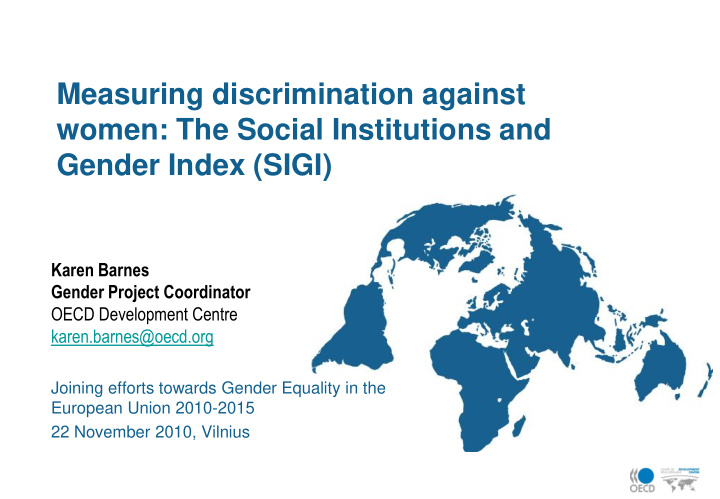



Measuring discrimination against women: The Social Institutions and Gender Index (SIGI) Karen Barnes Gender Project Coordinator OECD Development Centre karen.barnes@oecd.org Joining efforts towards Gender Equality in the European Union 2010-2015 22 November 2010, Vilnius
The Importance of Social Institutions What we can observe : Gender gaps in education What existing indicators School enrolment of women lower than men’s tell us: What policies we derive: Build more schools for women! Underlying reasons for low enrolment: What are the implications • girls not allowed to attend facilities of discriminatory social • girls married at early ages institutions? • girls expected to contribute to household chores and income instead of going to school 2
How do we measure Social Institutions? Social Institutions Variables 5 key areas of discrimination Family Code Physical Integrity Son Preference Civil Liberties Ownership Rights • Early marriage • Access to land • Female genital • Polygamy • Freedom of • Access to bank mutilation movement loans • Missing women • Parental • Violence against authority • Freedom of dress • Access to women property • Inheritance All variables are coded between 0 and 1. The value 0 means no or very low inequality and the value 1 indicates high inequality 3
SIGI: The Social Institutions and Gender Index 4
What does the SIGI show? What does the SIGI show? • Bottom performers among 102 developing countries: Sudan, Afghanistan, Sierra Leone • Top performers : Paraguay, Croatia, Kazakhstan 5
SIGI: The Social Institutions and Gender Index • Highest inequality : sub- Saharan Africa; Middle East and North Africa; South Asia • Lowest inequality : Latin America; Europe and Central Asia • Region with both high and low performers: East Asia and Pacific 6
How do social institutions affect development outcomes? How do Social Institutions affect development outcomes ? The higher the discrimination in social institutions, The higher discrimination in social institutions, the lower female labour participation the lower female to male literacy ratios 7
Applying SIGI to policy challenges: the MDGs • Countries where there are high levels of discrimination against women are also those performing most poorly on the MDGs • In the 21 countries that rank highest on SIGI, primary school completion is on average 15% lower, nearly twice as many children suffer from malnutrition and maternal mortality rates are twice as high • Exploring how women’s control over resources, their level of decision - making power in the family and household, and their degree of control over their own physical security can shed light on the bottlenecks that hamper further progress across all the MDG targets “ Gender Inequality and the MDGs: What are the Missing Dimensions ?”, OECD Development Centre Issues Paper, September 2010. http://www.oecd.org/dataoecd/11/56/45987065.pdf 8
Decision-making power and school completion rates (MDG 2) In the countries where more than half of girls aged 15-19 years are married (DRC, Niger, Afghanistan, Congo and Mali), on average fewer than half of primary school aged children are in school 9
Strengths • Focus on underlying causes rather than outcomes brings a new set of factors to the attention of policymakers • Allows for comparison across countries • Combination of both quantitative and qualitative data • Used by a growing number of UN agencies, NGOs and academic researchers • Can be used as a powerful advocacy tool 10
Limitations • Data availability and quality • Coverage • Drawbacks of using composite indicators • Methodological challenges ...has led us to extend SIGI in different ways... 11
Building on SIGI: new initiatives • Updating SIGI • New country notes and scoring in Q2 2011 • Discussion around conceptual/methodological issues • Country-level piloting • Adaptation of SIGI to different contexts • Collection of data at the sub-national level • More in-depth understanding of role of discriminatory social institutions • Document and assess policy interventions • Share lessons learned and good practices across different regions • Tools for sharing and personalising SIGI 12
“Traditional” tools for sharing data produced at OECD OECD.Stat -Metadata -Definitions -Exportable in .txt, .csv, .xls … Can be useful for researchers….but only if you know what you are looking for 13
New tool to share, explore, and explain data produced at OECD www,mygenderindex.org • Change weight of different social institutions in index • Drop social institutions from calculations • Filter by region • Ranking and Maps updates automatically 14
Wikis as community builders: the case of Wikigender 15 15
Reaching out globally and locally… Connecting experts, practitioners, the donor community and civil society to advance gender equality goals 16
Other work on gender statistics at the OECD • “Babies and bosses” database on gender, family and work issues • OECD DAC Credit Reporting System Gender Equality Marker • Horizontal project on gender equality: • Focus on gender equality in the 3 E’s: education, employment and entrepreneurship • Research and data collection in OECD and non-OECD countries • Development of indicators on women’s entrepreneurship 17
Ideas for collaboration • Collaborate on identifying indicators on discriminatory social institutions that are relevant to EU countries • EU member states and institutions could help us further develop wikigender as a platform for linking up policy and practice by sharing information, case studies, lessons learned, etc • OECD Development Centre could carry out research on issues relevant to development cooperation • Collaboration between EIGI and OECD on the new horizontal gender equality project 18
Recommend
More recommend